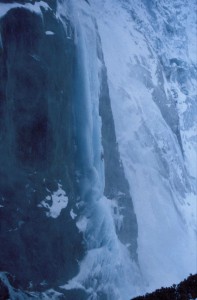Date: 25th November 2011
The video below (and linked Mixed Climbing Avalanche here, still figuring out WordPress) is really interesting. There aren’t that many videos of self-rescues done in the mountains. As I watched it I had some thoughts of course, but the main thing is that there are some good points to ponder in my own climbing and perhaps for others as well.
I don’t think these guys did a tremendous amount wrong. In fact, they did enough things right that they both lived–I have personally done far more wrong in the mountains, but had the good luck not to get called on it at the time. Many, many of us have made worse errors but just had, as my bud Barry Blanchard says, “Good luck when we needed it.” Ed, the injured climber, and Brice, the falling leader, did one thing amazingly well: they decided they are going to get the fuck off the mountain and live. Which they did; people have died with far lesser injuries. When I read of someone getting slung off a peak for a sprained ankle I think of guys like these: They cleaned up their own mess, well done, and anybody who wants to tear strips off of them had better be made of tougher material. That is unlikely.
I offer the following with full respect to the climbers; many people would not have done as well, including me at many points in my climbing career. I’ve been taking these guiding classes, and had some of my own weaknesses exposed, including rescue systems for my partners.
A few notes:
 -I’m no avalanche expert, but there’s obviously a shitload of wind transported snow blowing around. “Serious wind” is how it’s described in the video. Wind transported snow is often a big problem in the mountains. I once watched a healthy-sized avalanche scatter a dozen or so Chamonix guides and 20 or 30 clients on a perfectly blue day with high winds and a few cm of fresh snow from the night before. The guides were teaching ice/glacier clinics on a glacier below a roughly 500 foot cliff with a deposition zone above it. Snow built up overhead on the slope continuously, but the classes below were unaware of the hazard. I too didn’t know any better, I’d just climbed one of the classic hard routes under the same wind-transported snow slope and then walked across it, but it wasn’t loaded up yet enough to rip… We were high and across the small valley on another route when enough snow finally collected to release. We watched it all in slow-motion horror as the guides and clients ran for what they thought was their lives under the blue-bird sky… In the end some packs were lost but no lives, but that moment taught me to respect the power of wind-transported snow–it’s not just an “annoyance.” Anyhow, you can see the transport clearly in the video (in the air and with the spindrift) and it’s no surprise that a something finally releases on the leader. They are simul-climbing when it does blow.
-I’m no avalanche expert, but there’s obviously a shitload of wind transported snow blowing around. “Serious wind” is how it’s described in the video. Wind transported snow is often a big problem in the mountains. I once watched a healthy-sized avalanche scatter a dozen or so Chamonix guides and 20 or 30 clients on a perfectly blue day with high winds and a few cm of fresh snow from the night before. The guides were teaching ice/glacier clinics on a glacier below a roughly 500 foot cliff with a deposition zone above it. Snow built up overhead on the slope continuously, but the classes below were unaware of the hazard. I too didn’t know any better, I’d just climbed one of the classic hard routes under the same wind-transported snow slope and then walked across it, but it wasn’t loaded up yet enough to rip… We were high and across the small valley on another route when enough snow finally collected to release. We watched it all in slow-motion horror as the guides and clients ran for what they thought was their lives under the blue-bird sky… In the end some packs were lost but no lives, but that moment taught me to respect the power of wind-transported snow–it’s not just an “annoyance.” Anyhow, you can see the transport clearly in the video (in the air and with the spindrift) and it’s no surprise that a something finally releases on the leader. They are simul-climbing when it does blow.
-I have very few hard rules in ice/mountaineering, but I try to never to climb ice/mixed terrain when it’s raining, and to never to climb/ski/whatever in the winter when I can’t see the terrain over my head. I’ll push the “not seeing” rule when the consequences are low (I’m in the woods and confident I’m not threatened by anything over head), but not in alpine terrain. These rules have saved my life once or twice over the years for sure. These guys clearly can’t see much, but are going up. Often being “tough” does not end well in the mountains. When there is a lot of spindrift, wind and general chaos in the air I often get scared and run away. But there are all these tales in the magazines and on the internet about “pushing upward into storms.” Not good.
-I don’t think the leader put a Ti-block on his rope before he fell off. I like doing this, prevents the leader from going for a huge fall if the second blows it, or has an avi situation or whatever. I think the “wall of snow” hit the second before the leader was even done falling; a Ti-block might have really helped reduce the second’s injuries. Or it might not, but I think a Ti-block on the rope is a good idea if you’re already simul-climbing and pushing safety boundaries.
-The guy on rappel (Ed) doesn’t seem to have had his leg splinted at all after the accident, or much of a first-aid effort done. Maybe not the time and place for it, and he’s a tough bastard, but a splint would have been really good. It’s also unclear if his quadricep injury was at all evaluated or treated. Fortunately it wasn’t immediately life-threating, but it would have been good to know what was going on a little more I think.
-Why doesn’t Brice back Ed up with a Fireman’s belay (hold the ends snug) as Ed raps? Ed is a tough SOB, but it would have been prudent given Ed’s injuries. Or a prussik backup on Ed’s rope at least. A fireman’s backup would have been really ideal I think. Again, Ed is a tough SOB so all good, but I’m always looking for a bit more margin in the mountains. I backed up some friends last weekend as we rappelled through a small but forceful waterfall in Maui; it didn’t slow us down any, and it was prudent.
-Why doesn’t Ed’s partner rap with Ed on his back? That would keep Ed’s foot off the rock, and prevent a lot of pain for Ed.
-As the death crawl/crawl to life commences Ed’s leg still doesn’t appear to be splinted at all. This is just excruciating to watch…
-Was there any potential for emergency communications via radio, sat phone, SPOT, etc? If Ed’s injuries were just a bit worse emergency coms could have been very, very important. I do not head out into the mountains now without a Spot or a Sat phone, it’s just not worth it. I have yet to see a mountain accident scene where the victim said, “No, please don’t call for help, it’s against my wilderness ethic.” Like it or not the technology is there, and many of my friends are alive today because they had the means to communicate. A SPOT is only $100 right now, and the new DeLorme device looks cool when it goes public.
In any accident or intense situation there are almost always many things everyone involved would do differently. In this case Ed and Brice lived, and their video gives all of us an excellent opportunity to think about our own systems and approach to the mountains. What is our true knowledge level? Would we do anything differently?
Thanks to Ed and Brice for the video, and a beer or two is on me if I see you guys out there!
Posted in: Blog
Comment test, yo!
Will, respectful thoughts from you i think. But these guys are your everyday ‘accident waiting to happen’ in the mountains. Sorry. In hindsight i guess we have all been there, but as a professional guide i now see way too much of this ‘back slapping’ bullshit on the social media scene. Their first and most major mistake… was getting out of the car.
[…] Will Gadd offers an excellent analysis of how the climbers might have avoided the accident while also strongly praising their commitment to extricating themselves from the life threatening situation without outside help. Read more here. […]
Thanks much to Brice and Ed for sharing this. Never had to face a mountain rescue, so far.I strongly feel (and hope) watching that video and reading Will’s analysis allowed me to preject and question myself as in what rescue model am I able to set up for my partner? Hopefully, we will learn from other’s mistakes. Be safe in the mountains, everyone. And enjoy our gorgeous white season…
As a fellow climber who got flushed 400+ feet with my partner on similar mixed terrain by an avalanche, this video was interesting and tough to watch. It took my partner and I 7 hours to self rescue, each of us with crushed talus’s. We did have a SPOT on that occasion but made the choice to get ourselves out rather than involve many, many other people for what was not a life threatening situation. I learned a lot from the experience which was at the beginning of my alpine career. Glad the climbers lived and the video will hopefully serve as a warning to others…
Will, I’m confused about the tibloc suggestion. If the second falls with slack in the system, isn’t this quite dangerous? Seems like the same thing as shock loading a jumar.
Mike, the second shouldn’t let any major slack develop–it’s the second that actually controls the pacing in simul climbing in away, the leader can’t move any faster than the second can climb, and it’s the second’s responsibility to not move faster than the leader…
In this case the leader was knocked off and was falling/sliding/something, created slack in the system to the second when the second also falling, second went for a big fall. If there had of been a Ti-block there the rope likely wouldn’t have run at all while the second was falling, which might have reduced the distance the second fell. If the second lets 20 feet of slack develop and then jumps off then yes, it’s the same as shock loading any ascender, not good. In fact simul-climbing is sketchy in general, but if you’re going to do sketchy things to save time or for whatever reason then reduce the sketch factor as much as possible.
Gary–getting out of the car is almost always the first mistake we all make, grin… But seriously, do you think you or I did all that much better back in the day? I know I didn’t, I’m just hoping to get people thinking about what they would do in a similar situation, or to read the tea leaves a little better before getting hurt. If you get a minute maybe go through some the errors you see and fixes to same? Other than hiring you, which I plan to do one day, and congrats on being the full non-punter!
Will.
Number 1: Get switched on to the online weather forecast sites (NOAA in the U.S). You can pinpoint forecasts for your expected location/altitude. When it’s going to be that windy in the mtns i stay in bed with my good woman, go drinking with friends or hit the hotsprings!
Number 2: Get schooled or educated on some basic self rescue tools (online, books or guide programs). And make time each season to practice the stuff. Getting to the top of a climb is only half the battle, learning to retreat (especially in the case of an accident) is insurance well paid.
Number 3: Wilderness First Responder (WFR). Invest in yourself and your partners. Worth every penny. Real basics can kill you when you are a long way from help.
Number 4: If you’re going to much around in the snow, get wise to avalanche conditions. An AIARE level 1 avi course on reading and managing terrain is a must.
Remember peeps… this is not a game of golf!
Thanks, Will, for taking the time to share your perspective. The climbing/rescue particulars are very useful, but just as importantly, it walks the talk that we need to be able to share and discuss these things. As Cyril S would say: “wisdom comes from bad experience. The trick is to not let your bad experience(s) kill you.” The more we can share and discuss around events like this, the better. Kudos as well to Ed and Brice for being open enough to share, as I’m sure they knew that they were opening themselves up to being picked apart. Cheers!
Will,
While I understand the teaching opportunity provided by making the video I must admit I’m still surprised by it. I would hope that if I’m injured in the mountains one of the priorities isn’t making a video. No splint, no fireman’s assist on the rap but time to make a video? I find it curious that this aspect of the incident was not mentioned. I’m not sure if I could do any better but I do know my priority would be getting my injured partner to help as soon as possible and not making a video of the incident.
Mark
I am also a little confused by the tibloc suggestion. Do you recommend the leader attaching a tibloc to one of the pieces of protection between himself and the second? Is this really standard or recommended practice? If I understand correctly, then how much slack is too much for the second to allow to develop? Would a couple meters of slack present a problem? Seems to me that would be enough to shock-load the tibloc. I would think a second would have to be extremely diligent not to allow a certain amount of slack to accumulate from time to time while simul climbing.
Mark- with the increasing popularity of helmet cams (go-pro style) my take is that we are lucky to be able to learn from these videos. Perhaps it is my inner compulsive consumer but seeing these videos makes me think I would like to get one. (Here I go thinking “that way when I get in a big accident and of course I survive I can make a million bucks on the resulting video selling it to the highest bidder”) They are very simple and since they are already running, all it takes is a bit of post event editing to make the video. I certainly hear your point of where the true concern should lie in an event similar to this but I guess my comment is if you’ve got the technology and it isn’t really an increased burden then the potential for education for the greater community far outweighs the cost. That is, until every Joe-Schmo like me gets one and floods the interwebs with crappily edited movies thinking we are the next Spielberg… but I digress…
-Lucas
[…] privately emailed Ed, one of the people in the video I wrote about last week, and asked if he would like to post his thoughts here. He sent the words below; I think they are […]
I am also hesitant to use a tibloc in a dynamic system. I’ve heard that a camming unit with similar function such as the ropeman would be better in the above situation. Minimizes shredding I guess. Thoughts?
thanks for the writeup Will. best of luck to Ed for his recovery.
I also wanted to say, awesome Touching the Void reference with the Boney M song–“Brown Girl in the Ring” was playing in Joe Simpson’s head as he was crawling back to base camp off Suila Grande.
My understanding was that when the tibloc has been “tested” in the setup described, it has led to bad things and there is a very real chance of it cutting or shredding the rope.
My post to another tibloc thread on mountainproject.com (http://www.mountainproject.com/v/simul-climbing-with-a-tibloc/106610043__2#a_106611107):
Hans Florine wrote about using this [tibloc] setup. He and Bill Wright used a Tibloc when doing the RNWF of Half Dome in a day and sheared the sheath off the rope pretty badly when the second jugged through a short section. Apparently it is hard to ensure a good firm grip with the Tibloc on its own and it can just eat the sheath if left unattended. He switched over to using the Wildcountry Ropeman since it doesn’t have teeth. Dean Potter / Timmy O’neil and Hans florine / Yuji used the Ropeman when simul climbing sections of the Nose for that purpose as well.
Just FYI, Hans Florine’s book “Speed Climbing” has a whole section on simul climbing and is the only book I’ve ever seen that actually addresses it in detail. The pro’s, con’s, and how it’s actually done. Quite good stuff and a fun read if you’ve got $10 to drop.
note: I talked with Hans last spring, which is why I’ve got all the Hans info about the Tibloc, etc.. He’s also got a write up about it floating around somewhere on the net.
Firstly – Ed and Brice – here’s to a speedy recovery and I hope you both are out climbing again soon. Thanks for sharing your video. The following is not a rant at you two, but just some pointers for climbers, and hopefully some learning points.
Desptie the fact the root cause of the accident was mis-reading the avalanche conditions, why simul climb (move together here in the UK) in this case? Did the climb merit this tactic? looking back at the route at the end of the film, the cliff looks smalli-ish and it’s a shortish mixed climb. Was the speed vs safety trade-off justifable? (Please correct me if I’m wrong).
Would Ed and Brice have got away with it if they had pitched and put in (more) gear? Would a 200 foot whipper have been a 20 foot fall? I don’t know, as I’m only commenting on what I see in a video.
In general, too often on climbs – (particually here in Scotland) – we see climbers thinking moving together = speed = safety; when, like in this climb, we’re not on huge alpine faces.
You don’t need to move that quickly. The consquences on moving a bit slower is maybe getting to the top as it’s getting dark. In this case, it’s two miles to the road head – so hardly an issue! Here, is the slight extra speed justifiable at the expense of safety?
Here in Scotland where much of our winter climbing is very similar to this video – artic weather, windy, snowy, shit weather, short daylight and mountains 1-3 hours from the road – climbs typically 100-400 metres in length – moving together isn’t practiced as a norm, really. Maybe that’s why when we go to the alps we’re always last off the mountains ![]()
I await flames ![]()
Davy
I hope you had a medical insurance. Get better man.
Davy,
We were not simul-climbing to move faster. We were simply extending a standard ‘pitch’ so Brice could reach a place to build an anchor (and the terrain was well within our abilities). Not that we thought this out beforehand, but it is a very good thing we were simul-climbing. If Brice could have placed more gear (unlikely since that was why we were simul-climbing in the first place) that would have reduced the fall, but the avalanche still would have been set loose, and I would have been hurt much worse, because there would have been much less slack in the system (i.e.: I would have been held in place statically when the snow hit me).
Hope that helps. Enjoy your season – I’m looking forward to climbing in the UK one of these days.
I'm more than happy to hear your thoughts on what I've written. Please note that all comments will be moderated before publishing. Thank you for joining the conversation.



